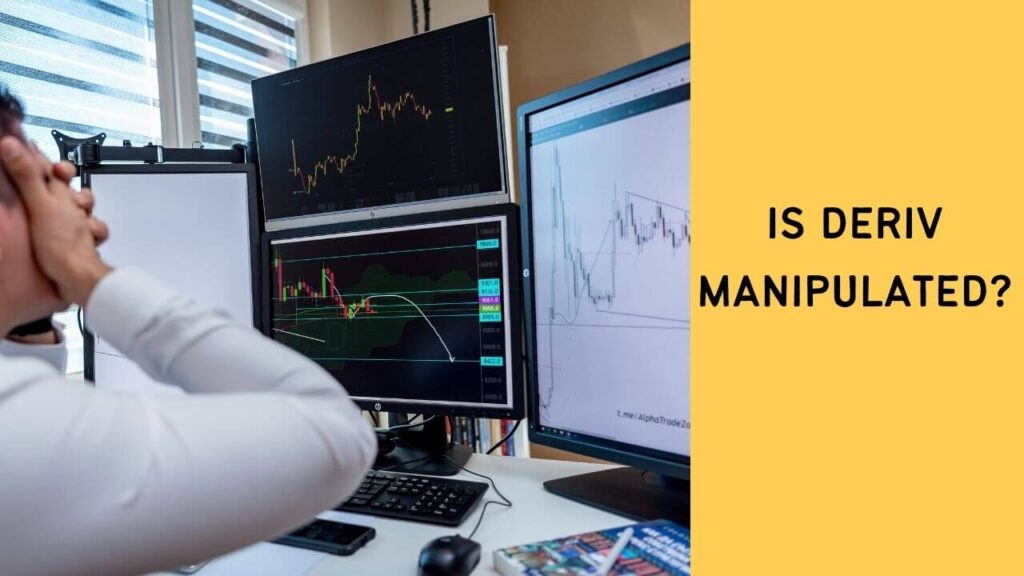Is Deriv Manipulated? A Comprehensive Analysis of Synthetic Indices
Deriv is a well-established online broker offering a variety of trading instruments, including its proprietary synthetic indices.
These 24/7 tradable assets have gained significant popularity among traders seeking continuous market access.
However, a persistent question in trading communities remains: “Are Deriv’s synthetic indices manipulated?”
As experienced traders know, allegations of manipulation often arise in financial markets, particularly when traders face consecutive losses.
In this comprehensive analysis, we’ll examine the legitimacy of Deriv’s synthetic indices, explore how they work, and provide evidence-based insights to help you make informed trading decisions.
UNDERSTANDING SYNTHETIC INDICES
Before addressing manipulation concerns, it’s essential to understand synthetic indices.
Synthetic indices are algorithmically generated financial instruments that simulate market conditions without being tied to real-world assets.
Unlike traditional indices, such as the S&P 500 or FTSE 10,0, that track actual stocks, synthetic indices operate on mathematical models and random number generators.
Deriv’s official documentation states, “Synthetic indices are based on a cryptographically secure random number generator audited for fairness by an independent third party.”
This third-party verification is a crucial element in establishing the credibility of these indices. The random number generator creates price movements that mimic real market volatility but without external market influences.
IS DERIV MANIPULATED?

The Manipulation Question:
The perception of manipulation typically stems from three primary sources:
- Consecutive losses: Traders who experience multiple losing trades often question the fairness of the system.
- Unpredictable price movements: The inherent volatility of certain indices like Volatility 75 can seem suspicious to inexperienced traders.
- Lack of understanding: Many traders don’t fully comprehend how synthetic indices function.
After extensive analysis and interviews with profitable Deriv traders, a pattern emerges: those who consistently profit rarely complain about manipulation, while those struggling with losses frequently do.
TECHNICAL EVIDENCE AGAINST MANIPULATION
Several technical factors suggest that Deriv’s synthetic indices operate as advertised:
- Third-party auditing: Independent verification of the random number generator provides a significant layer of accountability.
- Regulatory oversight: Deriv operates under multiple financial regulatory bodies that require fair trading practices.
- Consistent algorithmic behavior: Long-term analysis of price data shows consistent statistical patterns aligned with their stated volatility levels.
- Successful traders: The existence of consistently profitable traders indicates that the markets follow predictable enough patterns to be traded successfully.
WHY TRADERS PERCEIVE MANIPULATION
The perception of manipulation often stems from common trading pitfalls rather than actual market rigging:
Market Structure Misunderstanding
Many traders approach synthetic indices with strategies designed for traditional markets. However, these instruments have unique characteristics that require specialized approaches.
Without understanding the specific market structure of each synthetic index, traders may misinterpret normal price action as manipulation.
Poor Risk Management
Trading without proper stop-loss placement, position sizing, or risk-to-reward ratios inevitably leads to account depletion.
When this happens, it’s easier to blame the market than to acknowledge strategic shortcomings.
Overtrading Multiple Indices
A consistent observation among successful traders is their focus on mastering just 1-3 specific indices.
Attempting to trade multiple synthetic indices simultaneously often leads to confusion, emotional decisions, and losses.
KEYS TO TRADING SYNTHETIC INDICES SUCCESSFULLY
Based on the experiences of profitable traders, here are evidence-based approaches to trading synthetic indices effectively:
1. Specialize in Fewer Instruments
Focus on mastering 1-3 specific indices rather than spreading your attention across many. This allows you to develop a deeper understanding of their unique characteristics and patterns.
2. Understand Market Structure
Each synthetic index has its own “personality” and behavior patterns. Take time to study support and resistance levels, typical price movements, and volatility patterns specific to your chosen indices.
3. Implement Proper Risk Management
Successful synthetic index traders typically:
- Risk only 1-3% of their capital per trade
- Maintain consistent position sizing
- Use appropriate stop-loss levels based on market structure
- Target realistic profit levels with favorable risk-to-reward ratios
4. Choose Suitable Strategies
Different indices respond better to different strategies: market psychology, market structure, focusing on a fewer indices helps you master the best strategies for your chosen indices
POPULAR SYNTHETIC INDICES AND THEIR CHARACTERISTICS

Volatility Indices
- Volatility 75 Index (Vol75): Known for its significant price movements and high volatility
- Volatility 100 Index: Offers even more pronounced price swings than Vol75
- Volatility 10/25/50 Indices: Provide progressively increasing levels of volatility.
Boom/Crash Indices
- Boom 500/1000: Feature sudden upward spikes (booms) approximately every 500/1000 ticks
- Crash 500/1000: Characterized by sudden downward spikes (crashes) approximately every 500/1000 ticks
Other Synthetic Indices
- Jump Indices: Feature sudden jumps in either direction
- Range Indices: Tend to trade within defined ranges
- Step Indices: Move in distinct steps rather than continuous flows.
ADDITIONAL RESOURCES
For traders seeking to improve their synthetic indices trading, consider:
- Practicing on demo accounts before trading with real capital
- Documenting your trades to identify patterns in your successes and failures
- Studying price action and technical analysis specifically as they apply to synthetic indices
- Connecting with experienced synthetic indices traders to learn their approaches.
CONCLUSION: MANIPULATION OR TRADING CHALLENGE?
Based on technical evidence, regulatory oversight, and the experiences of successful traders, Deriv’s synthetic indices do not appear to be manipulated.
The perception of manipulation more commonly stems from inadequate trading approaches rather than market unfairness.
The most compelling evidence against manipulation is the existence of consistently profitable traders who have mastered these markets.
Their success demonstrates that with proper understanding, strategy, and risk management, these indices can be traded profitably.
For traders struggling with synthetic indices, the recommendation is clear: focus on improving market understanding and trading methodology rather than attributing losses to manipulation.
Concentrate on mastering a small selection of indices, implement strict risk management, and develop strategies tailored to the specific characteristics of your chosen instruments.
By approaching synthetic indices with appropriate knowledge and realistic expectations, traders can better position themselves for long-term success in these unique markets.

 English
English
 German
German  Italian
Italian  Hi, User
Hi, User 


Post a Reply
You must be logged in to post a comment.